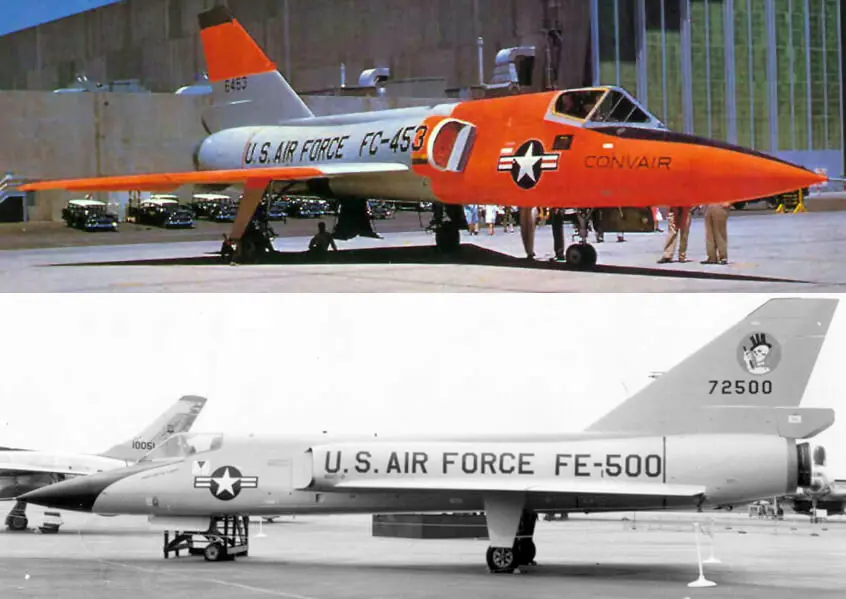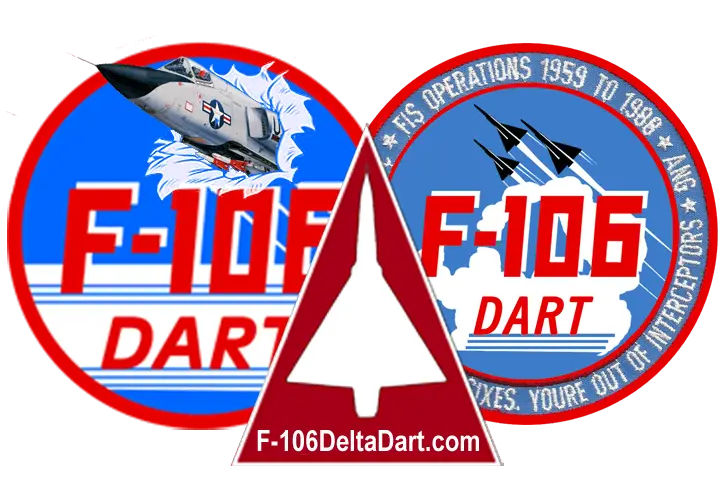Interesting Aspects of the F-106
When the Dart (or "Six") was new, it was something of a marvel to fly. Aside from its high performance flight envelope capabilities that made it a challenge to pilot, it was an extremely deadly and effective weapons system that any hostile airspace intruder had reason to fear. The heart of its deadliness was the advanced MA-1 airborne fire control system, developed by Hughes Aircraft and based upon the earlier F102A MG-10 system. Comprised of over 2512 pounds of navigational and fire control electronics, the MA-1 system's 200 separate black boxes full of hollow state devices' (vacuum tubes) formed a very formidable all-weather, fully automatic weapons suite for its time. While technologically obsolesced by today's state of the art aircraft guidance and control systems, the MA-1 system nevertheless represented the apex of contemporary aerial targeting and fire control systems of its day.
Due to advancements in SAGE and on-board data transmission links, it was fully capable of completely automatic interception and destruction of designated targets, as well as blind GCA and ILS flight in all categories of weather. In such a mode, the pilot was almost a redundant component! In the course of its development, the electronics (originally utilizing vacuum tubes in its black boxes) underwent continuous upgrading and improvement as solid state (transistorized) devices became the norm. There were, however, circumstances in which a human computer' on board was handy (such as in conditions involving fully automatic digital data link intercepts under unusual or divergent jet- stream and target heading situations), but no real Dart pilot worth his stuff would ever admit to the contrary, in any event!
It is worthwhile here to take a moment and examine a few of the characteristics & parameters of the F106A Delta Dart. With a fully loaded flight weight of over 40,992 pounds, a wing area of 705 square feet, and a single axial flow Pratt and Whitney J-75 turbojet engine rated at 24,000 pounds of thrust on full reheat, the F106A was a spectacular performer. If there was any criticism of the aircraft by its crews it was that it was hard to slow it down, for the aircraft liked to keep fast company. Zoom climb altitude was 74,255 feet, and normal service ceiling was 60,466 feet. Maximum maneuvering speed was Mach 1.9 at 42,431 feet. The length of the Six was 75 feet; its wing span was 40 feet, and its aspect ratio 2.2. Maximum speed was officially specified as Mach 2.31 at 42,431 feet altitude. Empty weight was listed as 23,695 pounds, while maximum take-off weight was given as 38,330 pounds. With two supersonic-rated external fuel tanks, each holding 360 gallons of JP4, maximum range was listed as 2,684 miles at 606.5 mph airspeed and 43,819 feet altitude, while combat radius was 572 miles with internal fuel only. Useable fuel load carried internally in the A model was 1740 gallons of JP4, stored in 8 wing tanks and one fuselage tank located behind the cockpit. Standard interception armament consisted of a combination of AIR-2A or AIR-2G Genie Nuclear Rockets, AIM4E/4F Super Falcon radar guided missiles, AIM-4G Super Falcon infrared seeking missiles, and an internally fitted General Electric M-61 20mm multi-barrel cannon with 75 rounds of ammunition (fitted only to some models later in the aircraft's development and which replaced the nuclear-tipped Genie rocket in the weapons bay).
One of the chief concerns arising with the new generation of supersonic aircraft of the Century Series, and particularly with the new Convair F106A was the need for a new generation supersonic-rated aircrew ejection seat system. The seat used in the F102A was limited in that it was not supersonic rated, nor was it useful in zero (altitude)-zero (speed) situations. In October of 1957 a requirement for a supersonic ejection system was issued by the US Air Force, which resulted in the ICESC Seat Program (Industry Crew Escape System Committee). Convair, under the supervisory administration of the ICESC, undertook primary development of a new seat that was to provide emergency escape for aircrew in all situational parameters, including supersonic and zero-zero ejections.
The ICESC Seat Program involved over 6 years of extensive testing (1 January 1956 through 30 June 1961) of the resulting Convair / ICESC "B" Seat system on rocket-powered sleds at Edwards Flight Test Center and Holloman AFB in New Mexico. These tests ultimately culminated with a live ejection test using a human volunteer at the White Sands missile test range in New Mexico. TSgt. James A. Howell ejected from a specially instrumented F106B aircraft at an altitude of 23,336 feet, and traveling at 497 mph. The seat, which employed a unique tilt-articulated, rocket boosted system, was installed in the early serial block F106A aircraft. Sled test ejections with dummies were run at speeds simulating Mach 2.5 at 9,700 meters altitude, with statistically satisfactory results. Additionally, 35 human test subject sled runs were concluded, verifying that ejections up to 560 mph airspeed were within the range of human endurance. The "tilt-seat", as some life support people came to know it, was not entirely satisfactory, however, and after several fatalities were sustained during actual in-flight emergency ejections in the supersonic rated tilt-seat, it was replaced in the F106 aircraft by a more conventional, rocket-powered seat made by the Weber Corporation (this seat was known simply as the "Weber Seat"), from 1964 through 1967. The Weber seat remained in the F106A & B type aircraft throughout the rest of the type's service life, and gave a satisfactory zero-zero escape capability, as well as a satisfactory high-speed ejection performance for almost all emergency aircrew escape situations. It should be noted that one of the motivations for replacement of the imperfect supersonic tilt-seat' with a conventional, rocket ejected seat stemmed from a gradual de-emphasis on high altitude, high speed parameter ejection capability, as actual operational experience had shown that most in-flight emergency ejections took place at much lower altitudes and slower speeds.
Another interesting aspect of the F106A advanced interceptor was that as originally designed, the first two prototype aircraft assigned to Edwards flight Test Phase Two evaluations were fitted with what would have been the first side-stick controls in an American military jet. Due to combined Convair / Air Force evolutional consensus, however, the prototype F106A aircraft were retrofitted with conventional center-stick controls (as were the subsequent production aircraft) prior to the start of the Phase Two (Air Force operational flight test) testing, and it was not until the introduction of the General Dynamics F16 Viper' that a side- controller stick became a standard military jet cockpit feature. As in other of its advanced design areas, the early form of this unique aircraft's control system was an expression of forward thinking, and had to be marginally conventionalized for practical purposes.
As with the earliest F102 interim' interceptor, the 60 degree leading edge wing sweep was kept and used just as had been called for in the original Lippisch experimental studies. In 1958 and 1959 the two-seat, air defense capable version of the Dart, designated the F106B, was delivered to Edwards Flight Test Center and following extensive testing, approximately 63 of these two-place aircraft were subsequently manufactured and used principally for training purposes (although they could be configured with the same weapons as the single seater and used for air defense, and performance specifications for both models were essentially identical).
By 1962 US Air Defense Command had 251 of the single seat F106A models, assigned to 14 squadrons in strategic sites around the perimeter of the United States. Although superbly suited to its primary area air defense role against strategic bomber penetration, by the late 60s it became apparent that there was a need to confer point-defense and general theatre air-superiority capability upon the F106. In view of its ability to engage in air-to-air refueling with world-wide deployment now possible, there was an increasing likelihood that it would come into contact with hostile fighters in some future conflict that took it out of its nominal pure interception environment. Thus a 20 mm M-61 Vulcan rotary barrel cannon was specially configured for use by the Six, the bulk of which could be carried within its internal weapons bay. The Vulcan equipped Dart was nicknamed "Six-shooter," and new training and tactics subsequently demonstrated that the venerable F106 Delta Dart was also quite well suited for use in its new air superiority role. Part of the Six-shooter modification included a new and very accurate "snapshot" gun-sight, and the installed Vulcan M-61 cannon could be carried and used with no interference to deployment of the normal load of Super Falcon missiles carried in the internal weapons bay. Among further refinements engineered into the Six was a cockpit heads-up display, an arrest barrier tail-hook, a clear bubble canopy' hood, and improved variable ramp air inlet ramps. F106 cockpit improvements included installation of advanced vertical tape' instrument displays, proven far superior to conventional "round-eye" (analogue) instrument gauges for conveying precise data quickly.
Further, over the course of its long service life, improvements in solid- state electronics provided welcome weight reductions in the massive and complex MA-I guidance and control system components, and which also reduced lengthy maintenance requirements substantially.



